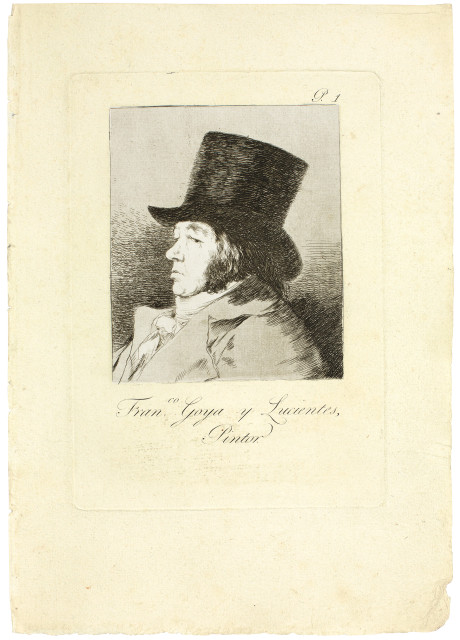- FR
S’inscrire
- Acheter
- Vendre
- Plus
- Galerie
- Commerce d'art
- Maison d'Édition
- Kornfeld aujourd’hui
- L'histoire de la Maison
- Informations


















Fuendetodos 1746 - 1828 Bordeaux
1796-1798, first edition 1799
Series of 80 etchings
plate mark, varying between 19,3x14,8 cm and 21,3x15 cm; sheet size consistent 31,4x21,7 cm
Harris 36-115, each III/1 (of 12), all sheets in the first edition of 1799
Delteil 38–117
Horatio Greenough Curtis Collection, Boston, 1844-1922; donated by his widow in 1922 to the Museum of Fine Arts, Boston
Museum of Fine Arts, Boston; sold in 1974 as "Deaccession", with stamp on cover, to
Private collection
Auction Christie's, Paris, 29.11.2005, cat. no. 63
Private collection Europe
Formerly brocaded copy of the 1st edition of 1799, broken up into single leaves. All leaves in original margins, not trimmed, with the two wrappers. All with traces of the old binding in the left margin. Splendid prints on handmade paper, without watermark, in uniform paper size. In perfect condition
The "Caprichos" ("inspirations") had been in the making since 1796; they were the first graphic works since the mostly purely linear etchings of 1778, the 16 interpretations after the paintings by Velasquez and the sheets of the "Garotted" and the Blind Singer. In the technical field, the sheets for the "Caprichos" are much more mature; above all, Goya now worked with aquatint, in some cases several layers, and thus achieved strongly painterly effects. Two of the sheets, Harris numbers 67 and 74, are created in pure aquatint. The new technique was developed in Paris in the second half of the 18th century, the French artist Jean-Baptiste Le Prince (1734-1781) is regarded as the technical master. In Madrid, the "Caprichos" had become technically possible thanks to the "Real Calcografía" created in 1789, which raised the printing possibilities, which had been quite rudimentary in Madrid until then, to a much higher, professional level
The success of sales of the set, which was perceived as very bizarre, was limited after 1799. In October 1803, Goya handed over all the plates and 240 copies of the complete set, which had not been sold until then, to the administration of the Royal Household (Carlos IV) in return for a pension of 12,000 reales in favour of his son Javier. The plates later passed to the Calcografía of the "Real Academia de Nobles Artes de San Fernando", 11 more editions were published from 1855 (2nd edition) and 1937 (12th edition)
The set offered here in rare fine print quality and condition, suitable as an exhibition copy.
1796-1798, erste Ausgabe 1799
Folge von 80 Blatt Radierungen
Plattenkanten variierend zwischen 19,3x14,8 cm und 21,3x15 cm; Blattgrössen einheitlich 31,4x21,7 cm
Harris 36-115, jeweils III/1 (v. 12), alle Blätter in der 1. Ausgabe von 1799
Delteil 38–117
Slg. Horatio Greenough Curtis, Boston, 1844-1922; als Schenkung seiner Witwe 1922 an
Museum of Fine Arts, Boston; 1974 verkauft als "Deaccession", mit Stempel auf dem Umschlagblatt, an
Privatsammlung
Auktion Christie’s, Paris, 29.11.2005,
Privatsammlung Europa
Ehemals brochiertes Exemplar der 1. Ausgabe von 1799, aufgelöst in Einzelblätter. Alle Blätter in den ursprünglichen Randverhältnissen, nicht beschnitten, mit den beiden Umschlagblättern. Alle links im Rand mit Spuren der alten Bindung. Prachtvolle Drucke auf Büttenpapier, ohne Wasserzeichen, in einheitlicher Papiergrösse. In tadelloser Erhaltung
Die "Caprichos" ("Eingebungen") waren seit 1796 im Entstehen begriffen, es waren die ersten graphischen Arbeiten seit den meist rein linear konzipierten Radierungen von 1778, die 16 Interpretationen nach den Gemälden von Velasquez und den Blättern des "Garottierten" und des blinden Sängers. Im technischen Bereich sind die Blätter für die "Caprichos" sehr viel ausgereifter, vor allem arbeitete Goya nun mit zum Teil mehreren Schichten Aquatinta und erreichte damit stark malerische Effekte. Zwei der Blätter, die Harris-Nummern 67 und 74, sind in reiner Aquatintamanier geschaffen. Die neue Technik war in der zweiten Hälfte des 18. Jahrhunderts in Paris entwickelt worden, der französische Künstler Jean-Baptiste Le Prince (1734-1781) gilt als der technische Vollender. In Madrid drucktechnisch möglich geworden waren die "Caprichos" durch die 1789 geschaffene "Real Calcografía", die die bis dahin in Madrid recht rudimentär vorhandenen Druckmöglichkeiten auf eine weit höhere, professionelle Stufe hob
Der Erfolg des Verkaufs der als sehr skurril empfundenen Folge hielt sich nach 1799 in Grenzen. Im Oktober 1803 übergab Goya sämtliche Platten und 240 Exemplare der bis anhin nicht verkauften kompletten Folgen der Verwaltung des Königlichen Haushaltes (Carlos IV) gegen eine Rente von 12'000 Reales zu Gunsten seines Sohnes Javier. Die Platten gingen später an die Calcografía der "Real Academia de Nobles Artes de San Fernando" über, es wurden ab 1855 (2. Auflage) und 1937 (12. Auflage) noch weitere 11 Auflagen publiziert
Die hier angebotene Folge in selten schöner Druckqualität und Erhaltung, geeignet als Ausstellungsexemplar



















